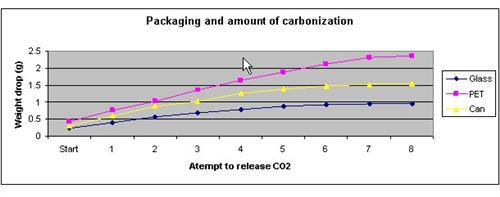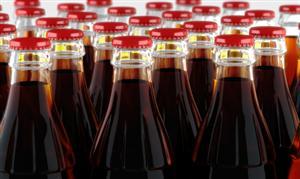| Complexity level: | 5 |
| Project cost ($): | 10 |
| Time required: | 1 hour to prepare, 1 day for experiment |
| Material availability: | Easily found at a supermarket |
| Safety concerns: |
Hypothesis
Coca-Cola beverage packed in glass bottles PET bottles or aluminum containers will have the same amount of carbon dioxide per 100ml.
Overview
Soft drinks
Soft drinks are sweet beverages that do not contain alcohol. Soft drinks are often carbonated. They are carbonated by dissolving carbon dioxide in the beverage at high pressure during packaging. Soft drinks can be consumed at room temperature or more oftenly chilled. Some popular carbonated soft drinks are Coca Cola, Pepsi Cola, Root beer, Ice cream soda, Sprite and many more. Since they do not contain alcohol, soft drinks are popular among children and adults.
Most soft drinks contain phosphoric acid and citric acid. The pH level of most soft drinks is between 2.5 to 4.0. The level of acidity in a soft drink may vary depending on the manufacturer, type and flavor of beverage.
Soft drinks are available in glass bottles, PET bottles and aluminum cans. Glass bottles are heavy and tend to break easily. PET bottles are more flexible and lighter but they have a shorter shelf life because of the gradual loss of carbonation. Aluminum cans are lightweight and better at holding carbonation but they have a shorter shelf life than glass bottles.
Scientific Terms
Materials
The materials required for the experiment:
- A glass bottle of Coca Cola 200ml
- A PET bottle of Coca Cola 500ml
- A can of Coca Cola 325ml
- A digital weighing scale (which measures in milligrams)
Procedure
1. For this experiment, the independent variable is the packaging of the Coca Cola beverage i.e. in a glass bottle, a PET bottle and aluminum can. The dependent variable is the amount of carbon dioxide released from the Coca Cola beverage. This is determined by using a digital weighing scale to check the weight of the bottle before and after releasing the gas in the beverage. The constants (control variables) are the room temperature and the type of beverage and the amount of beverage.
2. The Coca Cola beverage in the glass bottle, the PET bottle and an aluminum can are left to reach room temperature.
3. The initial weight of the Coca Cola beverage in the glass bottle is checked. The bottle is shaken 10 times. The bubbles are allowed to settle. Without letting any liquid escape from bottle, the cover is opened gently and the carbon dioxide gas allowed to escape. The weight of the bottle is measured once more and the weight difference recorded in the table below.
4. The top of the bottle is covered with a thumb or the palm and the bottle shaken 10 times again. The bubbles are allowed to settle and the weight measured once more. The difference in weight compared to the initial weight is calculated and recorded in the table below.
5. Procedure 4 is repeated 8 times and the results recorded in the table below.
6. Procedures 3, 4 and 5 are repeated with the Coca Cola in the PET bottle and the aluminum can. The variance in weight is recorded in the table below.

Results
The results show that the amount of gas that escaped from the glass bottle, PET bottle and aluminum can per 100 ml, after being shaken, is almost the same.
| Attempt | Packaging material and amount of CO2 released (grams) | ||||||||
| Start | 1 | 2 | 3 | 4 | 5 | 6 | 7 | 8 | |
| Glass | 0.23 | 0.41 | 0.56 | 0.68 | 0.79 | 0.88 | 0.93 | 0.95 | 0.96 |
| PET | 0.42 | 0.77 | 1.02 | 1.35 | 1.64 | 1.88 | 2.12 | 2.31 | 2.35 |
| Can | 0.32 | 0.59 | 0.88 | 1.02 | 1.27 | 1.39 | 1.48 | 1.52 | 1.54 |
| Packaging | Glass bottle | PET bottle | Can |
| Volume (ml) | 200 | 500 | 325 |
| CO2 released (gram) | 0.96 | 2.35 | 1.54 |
| CO2/100ml (g/100ml) | 0.48 | 0.47 | 0.47 |
The graph below represents the results of our science project experiment.

Conclusion
The hypothesis that Coca Cola beverage packed in a glass bottle, a PET bottle and aluminum will have the same amount of dissolved carbon dioxide per 100ml is correct.
Soft drinks like Coca-Cola comes packaged in glass bottles, PET bottles and aluminum cans. They are carbonized by dissolving carbon dioxide at high pressure in the beverages during packaging. The science fair project of the beverage gives it a fizzy taste and causes bubbles to form when the beverage is poured into a glass.
Also consider
Try to repeat the experiment with different beverages like 7-UP or Pepsi.
The experiment can also be repeated at different temperatures.
References
Soft drinks - http://en.wikipedia.org/wiki/Soft_drink
Packaging attributes - http://www.britishsoftdrinks.com/pdf/PackagingAttributes.pdf
How much CO2 is in a bottle of soda? - http://www.science-house.org/CO2/activities/co2/soda.html

